LA REBELDIA DE L@S INMIGRANTES.NEW YORK-BRONX.
12 DE ABRIL,2023.
https://larebeldiadelinmigrante.blogspot.com/
Las mujeres sostienen el 76,2% del cielo X Vijay Prashad.

Equipos de rescate luchan por salvar a 400 migrantes a la deriva en el mar Mediterráneo.
(CNN) -- La Guardia Costera de Italia lidera las labores de rescate de al menos 400 migrantes a la deriva en una embarcación en el Mediterráneo, entre Italia y Malta, en una ruta migratoria que las ONG advierten que es peligrosa.
Actualmente, se llevan a cabo tres operaciones de rescate con varios buques para ayudar a la embarcación de 400 migrantes, así como a otra embarcación con unas 800 personas a bordo, informó la guardia costera a CNN.
La embarcación en la que viajaban 400 migrantes se encuentra a unos 274 km al sureste de Capo Passero, frente a la costa de Calabria, y corre el riesgo de hundirse tras permanecer encallada al menos 24 horas.
El servicio de asistencia para el rescate de migrantes Alarm Phone dijo en un tuit este domingo que recibió una llamada de la embarcación, que partió de Tobruk (Libia) durante la noche, y añadió que se denunció la situación a las autoridades, pero que no se les comunicó ninguna operación de rescate.
Muchas personas a bordo necesitan atención médica, según Alarm Phone, entre ellas un niño, una mujer embarazada y una persona discapacitada. Los pasajeros informaron de que algunas personas angustiadas podrían haber saltado por la borda, incluida una persona que, según dijeron, estaba inconsciente en el barco. El casco del barco se había llenado de agua, añadió.
Se realizan operaciones de rescate para recuperar a cientos de migrantes a la deriva en un bote en el Mediterráneo este lunes. (Crédito: Guardia Costera de Italia)
Migrantes varados a lo largo de una ruta entre Italia y Malta que, según advirtieron los organismos humanitarios, es peligrosa. (Crédito: Giacomo Zorzi/Sea-Watch/Reuters)
Cada año, decenas de miles de migrantes que huyen de la guerra, la persecución y la pobreza se arriesgan a recorrer la peligrosa ruta en busca de mejores perspectivas económicas. Viajan en embarcaciones no aptas para la travesía y pueden quedar varados, lo que genera importantes disputas diplomáticas entre los países europeos de la región.
En 2022, llegaron a Italia 105.131 personas a través del mar Mediterráneo, según las cifras más recientes de la agencia de la ONU para los refugiados. De acuerdo con los mismos datos, 1.368 murieron o desaparecieron. En marzo, al menos 28 migrantes murieron tras naufragar las embarcaciones en las que viajaban frente a las costas de Túnez cuando intentaban cruzar el Mediterráneo para llegar a Italia.
En lo que va del año, 27.875 personas han realizado la travesía. La mayoría proceden de Costa de Marfil, Guinea, Bangladesh, Túnez y Pakistán.
La ONG alemana Sea-Watch International publicó en Twitter que había encontrado la embarcación el domingo y agregó que las autoridades maltesas ordenaron a dos buques mercantes cercanos que no rescataran a las personas a bordo, pero pidieron a uno de ellos que suministrara combustible, alimentos y agua a la embarcación. CNN puso en contacto con las autoridades maltesas para pedirles comentarios, pero aún no recibe respuesta.
Sea-Watch
dijo a CNN este lunes que el tiempo se había vuelto "muy malo" durante
la noche, con olas de hasta 1,5 metros. "Debido al número de personas en
el barco y a las condiciones meteorológicas actuales, existe un riesgo
urgente de que el barco se vuelque", dijo un portavoz de la ONG.
"Por lo tanto, el centro de coordinación de salvamento marítimo de Malta debe comenzar inmediatamente una operación de rescate. Sin embargo, en lugar de ello, los buques mercantes tienen instrucciones de limitarse a suministrar gasolina para que el barco pueda navegar hasta Italia por sus propios medios, lo que es terriblemente peligroso", prosiguió el portavoz.
Alarm Phone dijo en un tuit que logró volver a conectar con el barco durante las primeras horas de este lunes y agregó que los migrantes continuaron su viaje y habían llegado a la zona de Búsqueda y Rescate (SAR, por sus siglas en inglés) compartida entre Malta e Italia. "Informan de olas altas y viento fuerte. Todavía no hay rescate a la vista. No los abandonen en el mar, ¡sálvenlos ya!", reclamó la ONG.


Biden ends COVID national emergency after Congress acts.
ZEKE MILLER, AP White House Correspondent
4/10/2023
WASHINGTON (AP) — The U.S. national emergency to respond to the COVID-19 pandemic ended Monday as President Joe Biden signed a bipartisan congressional resolution to bring it to a close after three years — weeks before it was set to expire alongside a separate public health emergency.
The national emergency allowed the government to take sweeping steps to respond to the virus and support the country's economic, health and welfare systems. Some of the emergency measures have already been successfully wound-down, while others are still being phased out. The public health emergency — it underpins tough immigration restrictions at the U.S.-Mexico border — is set to expire on May 11.
The White House issued a one-line statement Monday saying Biden had signed the measure behind closed doors, after having publicly opposed the resolution though not to the point of issuing a veto. More than 197 Democrats in the House voted against it when the GOP-controlled chamber passed it in February. Last month, as the measure passed the Senate by a 68-23 vote, Biden let lawmakers know he would sign it.
The administration said once it became clear that Congress was moving to speed up the end of the national emergency it worked to expedite agency preparations for a return to normal procedures. Among the changes: The Department of Housing and Urban Development's COVID-19 mortgage forbearance program is set to end at the end of May, and the Department of Veterans Affairs is now returning to a requirement for in-home visits to determine eligibility for caregiver assistance.
Legislators last year did extend for another two years telehealth flexibilities that were introduced as COVID-19 hit, leading health care systems around the country to regularly deliver care by smartphone or computer.
More than 1.13 million people in the U.S. have died from COVID-19 over the last three years, according to the Centers for Disease Control and Prevention, including 1,773 people in the week ending April 5.
Then-President
Donald Trump’s Health and Human Services Secretary Alex Azar first
declared a public health emergency on Jan. 31, 2020, and Trump declared
the COVID-19 pandemic a national emergency that March. The emergencies
have been repeatedly extended by Biden since he took office in January
2021, and he broadened the use of emergency powers after entering the
White House.--
Send check pay to:
NISN/AFGJ
National Immigrant Solidarity Network
P.O. Box 751
South Pasadena, CA 91031-0751
Victor,
We
Are Not Your Soldiers is featured in an April article, "Veterans Push
Back Against Military Recruitment in Schools," in Yes! Magazine.
We Are Not Your Soldiers is a project of New York City-based nonprofit World Can’t Wait. The organization sends military veterans into schools to share honest stories of the harm they have caused and suffered. In doing so, they hope to prevent young people from signing up...
Sarah Gil, a school teacher at the City-As-School, a transfer high school in New York City, has brought veterans from We Are Not Your Soldiers to her classroom to speak to students in classes focused on just war, race and racism, economics, and moral responsibility. “They share their vulnerability, and it’s more than I could ever do with any of my lessons,” Gil says of the veterans’ visits.
Joy Damiani, an Iraq War veteran who served six years in the U.S. Army, has learned how to use that vulnerability more selectively over time. “I used to go into the classroom and spend a lot of time talking,” Damiani says. “[I was] trying to scare kids into not joining the military, because I was still so freshly traumatized from that.” More recently, Damiani says her role is less about trying to scare young people and instead providing an alternative perspective. “I’m trying to respect these kids by telling them the truth that other people are not telling them. I’m trying to give them something I didn’t have, which was somebody to bring the real talk right into my face where I needed it.”
“Usually, the students don’t have any idea of what it’s actually like,” Megaciph says. “Their narrative really comes from television and comes from the national narrative. ‘Thank you. Thank you for your service. It’s an honor to be a member of the military. Travel the world’ stuff.” While most students have a generally positive view of the military, Megaciph has noticed a shift in recent years. “I think in the past two years, maybe since the pandemic, there’s been a lot more talk about mental health in our country. And so I think in the past two years, I’ve seen more students aware of the trauma that veterans have.” Read more....
Each time one of the veterans speaks to a class, they receive a stipend to help cover childcare, time off work or school. All of that comes from you. Please donate what you can.
Next week in southern New Mexico, activists will protest at Holloman AFB, now the largest training base for U.S. drone pilots.
A call for volunteers to come out to the homeland of the Mescalero
Apache Nation in southern New Mexico for a mobilization of 300+
peacemakers to converge at Holloman AFB for a week of peaceful
nonviolent resistance against drone warfare and endless wars! Get information on how you can participate here.
We received this report on the global Guantanamo vigils held on April 5 from Andy Worthington and want to share with all of you. See and read about what took place in Washington DC, NYC, Mexico City, London and other locations around the world calling for the closure of the Guantanamo prison.
Posted on our affiliated site, Fire John Yoo, is this notice mourning the passing of Ben Ferencz, the last surviving Nuremberg prosecutor who died at the age of 103.

Debra Sweet, Director, World Can't Wait
Stephanie Rugoff, Coordinator, WeAreNotYourSoldiers.org
U.S. immigration policy causes migrant deaths
On March 30, Mexican police arrested three officials from the National Immigration Institute and two private security guards. The arrests occurred just days after a deadly blaze at a migrant detention facility in Ciudad Juárez. One of the incarcerated migrants, who has been accused of starting the fire, has also been arrested. (NPR, March 31)
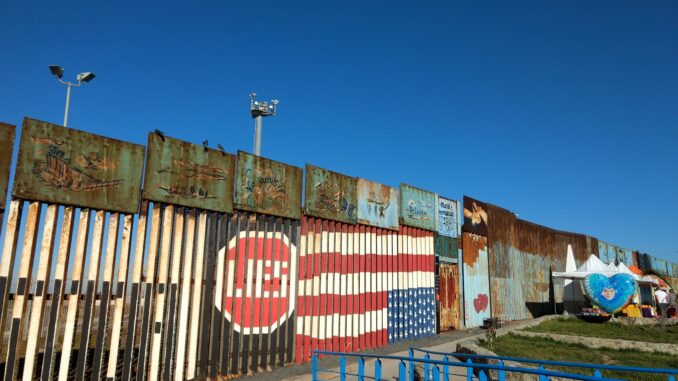
Mexico side of the U.S. border wall at Friendship Park in Las Playas de Tijuana, Baja California, December 2018. (Photo Credit: Ted Kelly)
![]() While an investigation into the fire, which killed 40 people, is underway, those really responsible are still at large.
While an investigation into the fire, which killed 40 people, is underway, those really responsible are still at large.
Regardless of how the blaze started — or who started it — the scope of this murder investigation must go beyond who lit the match. This criminal conspiracy goes further than the immigration agents who locked the cell doors and walked away, even as the victims cried for help.
The responsibility even goes above the heads of the prison officials who let the fire burn. According to the Ciudad Juárez fire department, no one at the detention center called emergency services. Instead, an on-duty captain saw the smoke and ran back to the station to alert others. Firefighters had to break down the cell doors to make a rescue. “It was a coincidence that we were fortunately able to get anybody out alive,” said one. (La Verdad, March 31)
Long before the smoke, long before the fire, this mass murder was premeditated. No one should have been in that facility in the first place.
Why were they there? Who created the conditions that forced these people to flee their homes and seek asylum elsewhere? Who drew a border across the map? Who forced these families into a no-win scenario, making them choose between prison or a perilous dash across deadly terrain?
Title 42 is a death sentence
Immigrants rights activists are correctly pointing to Title 42, a policy implemented by former President Donald Trump in 2020, which forced asylum seekers in the U.S. back across the border by tightening restrictions on who qualifies for asylum. The rule has enabled U.S. border agents to order 2.7 million expulsions since March 2020, according to the Washington Office on Latin America (WOLA). Fewer than 8% of all migrants encountered at U.S.-Mexico border checkpoints are granted asylum. (borderoversight.org)
“The U.S. and Mexican governments have prioritized the deterrence, the criminalization, the militarization, the discrimination versus the well-being of those seeking protection,” Tania Guerrero of the Catholic Legal Immigration Network told NPR.
Title 42, preposterously pitched as a public health initiative to stop the spread of COVID-19, is scheduled to end this May 11. In reality, Title 42 “denies migrants a chance to seek asylum, on grounds of preventing the spread of COVID-19, but enforcement has fallen disproportionately on Mexicans, Hondurans, Guatemalans and El Salvadorans, because those have been the only nationalities that Mexico agreed to take back.” (KPBS, March 31)
President Joe Biden has signaled that he will let Title 42 expire — as he has done to many other provisions that actually did help curb the spread of COVID-19. The White House may want to prevent the Supreme Court from ruling on the legality of the asylum ban, which Justices had voted to take up this March. After Biden’s announcement, the Supreme Court canceled its session to hear oral arguments on Title 42. (Roll Call, March 2) But whether or not Title 42 does expire, the White House is poised to make the policy permanent through other means.
The advocacy group WOLA was formed in 1973 by progressive clergy after the U.S.-backed military coup in Chile. WOLA’s Director for Defense Oversight Adam Isaacson says a transit ban “may deny asylum to people who passed through a third country en route and did not first seek it there. Aggressive use of ‘expedited removal’ could force asylum seekers to defend their cases within a few days, from the austere custody of U.S. Customs and Border Protection (CBP), without meaningful access to counsel. Ongoing negotiations with Mexico may enable thousands of removals of non-Mexican citizens across the land border.” (wola.org, Feb. 17)
Hard-line policies continue under Biden
Since his 2020 presidential campaign, which denied Trump a second term, Biden has painted himself as a compassionate, reasonable alternative to the hard-line and openly racist incumbent, especially when it came to immigration. Just last month, the White House released a statement claiming “Biden has taken historic steps to secure our border and rebuild a safe, orderly and humane immigration system that was gutted by the previous Administration.” (whitehouse.gov, March 9)
In the same statement, the White House boasts it has increased the budget of Customs and Border Protection (CBP) and Immigration and Customs Enforcement (ICE) by more than $800 million, for a total of nearly $25 billion.
Biden’s actual record on immigration is completely in line with that of his predecessors, dating back to the 18th century — which is to say, neither humane nor safe.
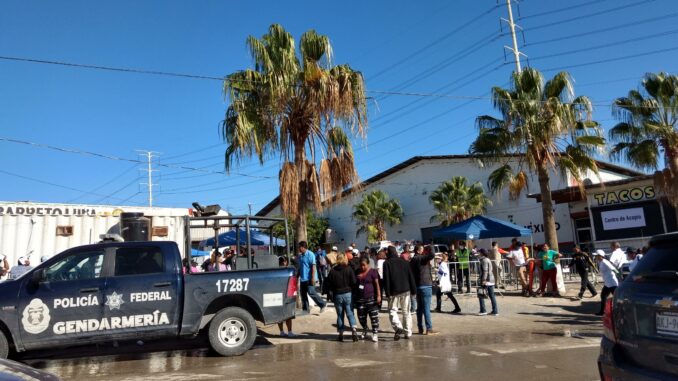
Outside a refugee camp in Tijuana, Mexico ten miles south of the U.S. border. Hundreds of asylum seekers stranded here were denied entry at the San Diego border crossing. December 2018. (Photo Credit: Ted Kelly)
As a senator, Biden supported the “Secure Fence Act of 2006,” signed into law by President George W. Bush, which authorized construction of 700 miles of partition walls along the Mexican border. In a primary debate in 2008, during his second failed bid to become president, Biden defended his border-fence vote on the basis of preventing drug trafficking. Referring to “14 million illegals,” he pledged to “take out the criminals” and “get them back.” Then-Senator Barack Obama chimed in afterwards, “I think Joe is exactly right.” (NY Times, June 3, 2007)
It has only been seven years since the end of the presidency of Obama, whom Biden served as second-in-command. Obama, known by his second term to immigrant rights activists as the “deporter-in-chief,” expelled more people than all U.S. presidents before him combined. Biden stood next to him making wisecracks during every one of those 3,066,457 deportations.
Theft, exclusion and displacement
Land theft, racist exclusion and violent displacement have been the cornerstones of U.S. policy. In his first term as president, the wealthy slave owner and tobacco trafficker George Washington signed the Naturalization Act of 1790, which restricted the naturalization of citizens to “free, white persons” of “good character.” Despite the passage of the 14th Amendment in 1868, it took another two years before people of African descent were permitted to become citizens.
Native Americans were barred from becoming citizens until 1924, when President Calvin Coolidge signed the Indian Citizenship Act. While Congress made it legal for people of Asian origins to become naturalized in 1898, the Chinese Exclusion Act of 1882 remained in effect with some revisions until 1943.
Throughout most of the 20th century, between 1893 and 1993, the U.S. deported an average of roughly 17,500 people a year, with notable spikes during periods of imperialist war abroad and worker uprisings at home. In the aftermath of the Spanish-American War, President Theodore Roosevelt ordered deportations at a rate seven times higher than that of his predecessors.
The Immigration Act of 1903, signed by President Roosevelt, targeted poor people, worker organizers, sex workers and disabled people, especially those with epilepsy. Also referred to as the Anarchist Exclusion Act, the policy was introduced in the aftermath of the Haymarket Affair and the assassination of President William McKinley, using accusations of anarchism to round up and deport migrants. Roosevelt deported over 76,000 people between 1901 and 1909.
Then, 15 years later, just weeks before the guns fell silent signaling the end of World War I, the administration of Woodrow Wilson expanded its powers through new immigration acts passed in 1917 and 1918 in order to better expel and incarcerate anarchists, communists, labor organizers and antiwar activists. Wilson deported more than 162,000 people between 1913 and 1921.
At the same time, the U.S. was adapting the tactics it had first deployed a century prior against the Indigenous nations of North America. Concentration camps were erected to incarcerate Italian, German and Jewish immigrants. Tens of thousands of arrests were orchestrated by Attorney General A. Mitchell Palmer between 1919 and 1920. These roundups and subsequent deportations are known as the Palmer Raids and were an explicit response to the Bolshevik Revolution in Russia and the awakening of a global workers’ consciousness.
A mid-century spike in deportations ordered during the Franklin Delano Roosevelt presidency — nearly 172,000 deportations between 1933 and 1945 — accompanied the mass incarceration of at least 125,000 Japanese people across 75 internment camps. Four months later, in preparation for its invasion and occupation of Alaska and the Aleutian Islands, the U.S. arrested almost 1,000 Native Unangax̂ people, 10% of whom are estimated to have died in the concentration camps. (Workers World, March 7, 2022)
Waging a 30-year war against refugees
A 2021 fact sheet from the American Immigration Council found the U.S. government had spent billions of dollars on immigration enforcement since the creation of the Department of Homeland Security 18 years earlier. “Since the creation of DHS in 2003,” the report states “ICE spending has nearly tripled, from $3.3 billion to $8.3 billion today. Much of this funding has gone to increasing the agency’s ability to hold immigrants in detention in locations around the country.” (AIC, Jan. 20, 2021)
The AIC also notes, however, that the current hypermilitarized U.S. border policy so much associated with Trump can actually be traced back to the very beginning of the Clinton administration, 30 years ago. It states, “Since 1993, when the current strategy of concentrated border enforcement was first rolled out along the U.S.-Mexico border, the annual budget of the U.S. Border Patrol has increased more than 10-fold, from $363 million to nearly $4.9 billion.”
We ought to consider what happened in 1993 as the beginning of a new phase of military offensive targeting one of the most vulnerable and oppressed sectors of the working class. Since then, the U.S. has waged a 30-year war on refugees.
It started with Silvestre “Silver” Reyes, a U.S. Army captain in command of a helicopter unit during the Vietnam War, who joined the Border Patrol in 1969 after returning home to Texas. In 1984 Reyes became Sector Chief and later Chief Patrol Agent of El Paso, during which time he developed a strategy to apply overwhelming military force to border enforcement. By 1993, Reyes deployed 20,000 border patrol agents directly on the border and across major urban areas.
The CBP’s own history describes the policy — dubbed “Operation Hold the Line” — as a “show of force to potential illegal border crossers.” (cbp.gov)
A subsequent operation by the El Paso Border Patrol under Chief Reyes, Operation Blockade, involved “400 agents posted round the clock in high-visibility fashion directly along the Rio Grande international boundary between El Paso and Ciudad Juárez for miles.”
In his book, “Blockading the Border and Human Rights: The El Paso Operation that Remade Immigration Enforcement,” author Timothy Dunn calls the operation “a historic turn in Border Patrol enforcement efforts” that “sparked a series of new Southwest border region operations to discourage undocumented border crossers in the main long-standing, unauthorized border-crossing areas (in and around several border urban centers) and to divert or displace them to more remote and hostile terrain.”
Dunn argues that “Operation Blockade/Hold-the-Line marked a profound change in Border Patrol enforcement efforts along the U.S.-Mexico border, and though its origins lay in a reaction to civil rights abuse claims (largely rooted in a citizenship-nationalistic view of rights), profound human-rights problems ensued once it became the model for border enforcement.” El Paso became “the foundation for a rewriting of the Border Patrol’s national strategy.”
One of the most successful challenges to this militarization of the border under Chief Reyes came from teenagers at Bowie High School, located just yards away from the U.S.-Mexico border. The Latinx students organized protests and appealed to staff at the high school, after a pattern of harassment by border patrol agents. They were repeatedly stopped, questioned and forced to show identification and proof of citizenship.
In one incident, reported at the time, “a Border Patrol agent pointed a gun at the head of Coach Benjamin Murillo, after stopping him as he drove some of his students to a varsity football game.” The students and staff brought a lawsuit against the U.S. Border Patrol in federal court, which found that their civil rights had indeed been violated by the policies. (United Press International, Dec. 4, 1992)
This unprecedented rebuke by a U.S. District Court Judge leveled against the Border Patrol did not deter Attorney General Janet Reno from holding a press conference with Chief Reyes in 1995, whom she counted among “special heroes of mine.” Reno went on to say that she had visited the border in San Diego and came away dissatisfied.
The two briefed the commander-in-chief directly: “We have just come from a meeting with President [Bill] Clinton, at which time he signed a presidential memorandum directing our agencies to move forward with new initiatives to gain control of our border and better enforce our immigration laws.” (Transcript, Feb. 7, 1995)
Before the year was out, “Operation Gatekeeper” was deployed in California, based on the model provided by Texas, where George W. Bush had just been elected governor.
Border Patrol in Arizona adopted similar tactics to Reyes’ with the support of another Vietnam-era war criminal, John McCain, who was then U.S. Representative to Arizona’s First Congressional District. Like Biden, McCain would foster a reputation as an immigration reformer, despite his history of voting against a 1986 amnesty for 2.5 million undocumented immigrants and his dangerous scapegoating of Mexican migrants, whom he claimed were responsible for wildfires in Arizona, and his crusade to complete the construction of a U.S. border wall, long before Trump ever ran for president.
Also in 1993, the notorious human rights abuser Joe Arpaio ended his 25-year tenure at the Drug Enforcement Agency to become the sheriff of Maricopa County, located right in McCain’s district.
Understanding this history helps show how 1993 marked a turning point in border enforcement strategy, ushering in a national rollout of police terror against oppressed people and migrants. But perhaps the deadliest aspect of this strategy was how the threat of violence at checkpoints coincided with the elimination of legal pathways to entry. To reiterate Dunn, the new national policy toward those crossing the border illegally was “to divert or displace them to more remote and hostile terrain.”
‘It’s like a graveyard’
How dangerous is it to attempt to cross the U.S. border illegally today? The CBP’s own reporting suggests they discovered 7,500 corpses of refugees between 1998 and 2018. (cbp.gov, 2019) That’s before Title 42 was implemented.
“Without any type of relief for them and with measures that continue to deny them the ability to present themselves at a port of entry for asylum, we will continue to see migrants [who] will injure themselves or die,” said Pedro Rios, an activist with American Friends Service Committee.” (KPBS, March 13)
Describing the policy of “Prevention through Deterrence,” funeral industry reform activist Caitlin Doherty said: “This is government strategy. The hope is that people will see how dangerous crossing this inhospitable terrain is and how many people have died and just decide not to do it themselves.” (“Why migrant bodies disappear,” 2019) “Deaths are a success,” she added. “Deaths are a sign that the plan is working.”
By this grim metric, U.S. border policy is becoming more “successful” than ever. The United Nations reported the number of migrant deaths in 2019 as 497, one of the highest on record. (un.org, Jan. 28, 2020) In 2020, the year Title 42 took effect, the remains of 227 migrants were found in Arizona. (Guardian, Jan. 30, 2021)
In 2021, the nonprofit Humane Borders reported finding 43 bodies in the Sonoran desert during the month of June alone. Brad Jones, a volunteer, said: “What is happening is climate change is real, and the temperatures have been getting hotter, and the weather itself is more volatile.” (Voice of America, Aug. 2, 2021) June 2021 was the hottest on record for Arizona, where heat-related deaths have increased more than 60%. (Guardian, Jan. 27, 2022)
The official death toll subsequently increased by 58%, as 800 people died during attempted crossings between September 2021 and 2022, the highest reported by CBP to date. In June of last year, 53 people died in a single incident, when locked in the back of a tractor trailer outside San Antonio. (Texas Tribune, June 27, 2022) Maverick County Sheriff Tom Schmerber told the Wall Street Journal: “It’s like a graveyard. I’ve been working on the border for almost four decades and never saw tragedies of this magnitude.” (WSJ, March 17)
It must be kept in mind that these reported death tolls are only the official counts of recovered bodies. In his book, “The Land of Open Graves,” Professor Jason de León, professor of Anthropology and Chicana, Chicano and Central American Studies at UCLA, posits that people are dying on a daily basis attempting to cross the Sonoran desert. His research has found the climate, wildlife and terrain in these regions makes the recovery of corpses extremely difficult and therefore suggests the death toll from attempted crossings is much higher than reported.
Doherty, the Los Angeles-based mortician, said that in 2019 “an estimated 10,000 people died trying to cross the border from Mexico to the U.S., a number vastly underreported by the U.S. government. But why are so many people dying? Is the government aware this is happening? Yes! They are. Their plan is working.” (“Why migrant bodies disappear,” 2019)
The deadly fire in Ciudad Juárez proves that refugees and migrants are put in an impossible position by U.S. border policy: risk dying in prison or risk dying in the desert. The callousness and cruelty of the border agents and the capitalists who give them their marching orders must not be permitted to continue. The only way to stop the mass death on the U.S. border is to make passage between the U.S. and Mexico safe and legal.
Free them all! Full legalization now!
NISN/AFGJ
National Immigrant Solidarity Network
P.O. Box 751
South Pasadena, CA 91031-0751
Date: Wed, Apr 5, 2023
Subject: Haiti : The Truth Speaks for Itself
To: Dorinda Moreno <pueblosenmovimientonorte@gmail.com>
Haiti: “The Truth Speaks for Itself”
by Robert Roth, Haiti Action Committee
On December 16th, 2022, Fanmi Lavalas – the people’s party of Haiti – released a statement commemorating the 32nd anniversary
of
the first democratic election in Haiti’s history. In that election,
the Haitian people chose Jean-Bertrand Aristide as their president,
only
to see their historic victory overturned seven months later as the
result of a bloody U.S.-orchestrated coup d’etat. Drawing on the
lessons of that period, the Lavalas statement connected the events of 1990-1991 with the crisis facing Haitian society today:
“The
truth speaks for itself: If there had not been a coup d’etat, today
many of the beautiful dreams of the Haitian people would have
already
materialized. With justice, transparency, participation, there would
be food for everyone, housing for everyone, schools for all
and health care for all.”
“32
years after the victory of December 16, 1990, we are witnessing how the
anti-democratic forces have failed. They have failed because
the
country has become a hell on earth. Everywhere is kidnapping,
insecurity, misery, hunger, excessive cost of living, corruption,
economic
crimes, political crimes in a hell that is called a country.”
Today, the situation in the country could not be more dire. The unelected and illegitimate de facto prime minister Ariel Henry remains in power
despite
continuous mass protests demanding his ouster. Henry was hand-picked
by the U.S. and its allies in the so-called Core Group of foreign
occupiers
that exercises colonial control over Haiti. Like the series of
U.S.-imposed governments that have infected Haiti since the 2004 coup
against
the second Aristide administration, the Henry government has proven to
be a disaster for the Haitian people. Following the dictates of the
IMF and its structural adjustment policies, the Henry regime removed government subsidies on fuel prices, resulting in dramatic hikes in the cost
of gas, food and other basic necessities. In response, Haitians took to the streets by the tens of thousands in a series of militant and powerful protests.
With
collapsing infrastructure and a defunded health care system, Haiti is
once again confronting a cholera epidemic. Food insecurity now
threatens
nearly 5 million people, including 2.4 million children,
in a country of 12 million. Government-supported paramilitary groups
continue to terrorize
opposition neighborhoods, with kidnappings at an all time high.
These
crises have their roots in the 2004 coup and the subsequent imposition
of foreign occupation, coordinated through the United Nations. And yet,
without a trace of irony, the same foreign powers and corrupt
rulers responsible for this situation are now asking Haitians to believe
that more
intervention and more elite anti-democratic rule will somehow change all of this.
Fearful
that the Henry regime is on its last legs, the U.S. and the U.N. have
been lobbying other countries, including Canada, Mexico and the CARICOM
nations,
to become the face of yet another round of military intervention to
insure that Haiti’s popular movement is kept from power. In a sign of
things to
come, the Canadian government, which was a key organizer of the 2004 coup d’etat, has just sent warships to patrol off the coast of Haiti. Speaking to a
reporter
from NPR, one Haitian activist made clear the anti-intervention
sentiments of so many as he recounted the track record of the UN
occupation that
descended on Haiti in the wake of the 2004 coup: “All they brought was kidnappings and rape and cholera,” he said. “If the U.N. sends troops to Haiti, the
fighting will get even more intense.”
Trotting
out the familiar argument that “gang warfare” is the root of Haiti’s
problem, the U.S. and Canada are also ramping up funding and training
for Haiti’s
notorious and corrupt national police force, including sending tactical and armored vehicles. The same militarized policing that has produced a wave of murders
of
unarmed Black people in the United States will continue to be exported
to Haiti to bolster an already brutally repressive police force.
Police/paramilitary massacre in Bele
Just
this past week, the people of Bele (BelAir) – a Lavalas stronghold that
has been under constant attack for the past three years – have had to
defend themselves
against a paramilitary assault by the G-9
federation headed by Jimmy Cherizier, otherwise known as Barbecue.
According to eyewitness reports, over 60 people
were killed and more
than 50 others disappeared. Similar to the Lasalin Massacre in 2018,
community residents reported seeing three police armored personnel
carriers
shooting residents, burning homes and transporting G-9 members. All of
this was accompanied by a deafening silence from the Henry regime.
These
crimes took place one day after a CARICOM delegation visited Haiti, promising increased support for the Haitian National Police.

As
his government teeters on the brink, Ariel Henry has rolled out his own
hand-picked transitional council, which would supposedly organize
elections in 2024.
Orchestrated by the U.S. State Department, it
keeps in power the same dictatorship that created the terror now
engulfing Haiti -- laying the foundation for more
stolen elections
and further destruction of civil society. Fanmi Lavalas and other
opposition parties have rejected the phony transition promoted by Henry
and his
imperial backers.
“The
transition that the Haitian people want cannot take us from bad to
worse. No. The transition that the Haitian people want is a complete
break with this system
of corruption to put an end to this ever-boiling cauldron of misery.” (Lavalas)
The Biden Administration has also announced a new, draconian anti-migrant plan to be instituted when Title 42, Trump’s Covid-19 era vehicle used to block refugees
from
seeking asylum, comes to an end on May 11. Biden’s plan would summarily
deport any migrant who comes across the Mexican border without hearing
any
claims for asylum. Haitians are a primary target of the new
directive....Even a former Biden White House official, Andrea Flores,
denounced the move, stating that,
“the
Biden Administration has resurrected a transit ban that normalizes the
white nationalist belief that asylum seekers from certain countries are
less deserving of
humanitarian protections.” More than 25,000
Haitians have been deported since Biden took office and those numbers
will surely swell. As the U.S. stokes the flames
in Haiti, it will have the Border Patrol and the Coast Guard standing ready to make sure that Haitians cannot flee the fire.
Nineteen
years after the February 29, 2004 coup that overthrew democratic and
progressive governance in Haiti, the Haitian popular movement remains
powerful
and dynamic. As the people of Haiti deepen their fight to
end this oppressive system, the U.S. is orchestrating a new series of
maneuvers to keep it squarely in place.
The crisis is sharpening and the stakes could not be higher.
* Support the popular movement in Haiti.
* Demand an end to U.S. funding for the Haitian National Police and military.
* Demand an end to the Biden Administration’s unconscionable attacks on refugees.
March 14, 2023 - Robert Roth is an educator and a co-founder of Haiti Action Committee
This email is intended for pueblosenmovimientonorte@gmail.com
Date: Wed, Apr 5, 2023

Send check pay to:
NISN/AFGJ
National Immigrant Solidarity Network
P.O. Box 751
South Pasadena, CA 91031-0751
Inquilinos de Nueva York: ‘Sólo pedimos algo de retribución’.
Cientos de inquilinos se hicieron escuchar en Albany en reclamo a que tanto la gobernadora como la Legislatura estatal den luz verde a la Ley de Causa Justa para frenar los desalojos y el Programa de Vales de Acceso a la Vivienda.
“Si pedimos ayuda es por las circunstancias. Han sido tres años de sufrimiento, ganando apenas para comer o sobrevivir. Pero con nuestro trabajo hemos aportado a que la ciudad estuviera activa, sólo pedimos algo en retribución”, dijo el hondureño Jorge Vargas.
Como Vargas, la mayoría de los inquilinos que claman por ayuda son inmigrantes y trabajan en la industria de servicios, restaurantes y repartidores de comida.
Más de 200.000 neoyorquinos están en la vía de ser desalojados, una vez que el pasado 15 de enero expiró la moratoria de rentas en el estado de Nueva York, que estuvo vigente durante la pandemia del COVID-19. Según los defensores, esa medida protegió por más de año y medio de ser desalojados de sus casas y apartamentos a los inquilinos que no podían pagar.
Los inquilinos que enfrentan desalojos y aumentos de alquiler hablaron sobre lo que significaría para ellos la aprobación de las medidas.
Algunos funcionarios electos apoyaron la protesta, entre ellos los senadores estatales Mike Gianaris, Brian Kavanagh, Jabari Brisport, Kristen González, Brad Hoylman-Siegel, Rachel May y Julia Salazar, y los asambleístas Linda Rosenthal, Steven Raga, Jessica González-Rojas, Latrice Walker, Marcela Mitaynes, y Brian Cunningham.
Compromiso de los neoyorquinos
El Senador Brian Kavanagh, presidente del Comité Senatorial de Vivienda, autor de la legislación del Programa de Vales de Acceso a la Vivienda y copatrocinador del proyecto de ley Buena Causa, dijo que todos los neoyorquinos están comprometidos a poner fin a la crisis de personas sin hogar, la crisis de los desalojos y los aumentos alquiler.
En ese sentido la asambleísta Marcela Mitaynes dijo que el estado debe respaldar a los inquilinos para luchar por protecciones significativas en el presupuesto estatal en las próximas 3 semanas.
“Este año, no podemos quedarnos de brazos cruzados e ignorar la crisis de vivienda que tenemos en nuestras manos”, dijo Mitaynes.
Entre tanto desde Community Voices Heard, su directora ejecutiva Juanita O. Lewis dijo que las protecciones para inquilinos son un paso fundamental hacia la justicia racial en el estado de Nueva York.
“Más de dos tercios de las familias afroamericanas en el estado de Nueva York alquilan. Y entre los inquilinos, los hogares afroamericanos son los más vulnerables al desalojo. Es hora de que el Estado actúe”, subrayó Lewis.
La directora de Acción Ciudadana de Nueva York, Rebecca Garrard destacó que todos merecen un lugar seguro para vivir.
“Estamos pidiendo una inversión en inquilinos y personas marginadas primero. Ley de Causa Justa para frenar los desalojos y el Programa de Vales de Acceso a la Vivienda, es una oportunidad para que los inquilinos se unan y compren las propiedades en las que viven: estas son las políticas que necesitamos que nuestros legisladores en Albany defiendan para la gente”, dijo Garrard.
Mientras los legisladores estatales están en medio de las negociaciones del presupuesto estatal, los manifestantes buscan que se proteja a los inquilinos aprobando las iniciativas de ley que les beneficien.
Los manifestantes arremetieron contra la gobernadora Hochul, que, según ellos, de forma reiterada se ha negado a tomar una posición sobre el proyecto de Ley de Causa Justa, incluso cuando los inquilinos la confrontaron.
Acusan a la gobernadora de haber recibido millones por parte de promotores inmobiliarios y propietarios, mientras que excluye explícitamente cualquier protección a los inquilinos en su plan de vivienda dentro del Presupuesto Ejecutivo para el Año Fiscal 2024.
En contraste, la otra cara de la moneda proviene de la Legislatura. Tanto el portavoz de la Asamblea Estatal, Carl Heastie como la líder de la mayoría, Andrea Stewart-Cousins incluyeron un compromiso a favor del proyecto de Ley de Causa Justa y el Programa de Vales de Acceso a la Vivienda.
Los promotores defensores de los inquilinos destacaron que el periódico New York Times publicó esta semana un editorial a favor del proyecto de Ley de Causa Justa, diciendo que “abordar la crisis de la vivienda significa mantener a las personas en sus hogares e impulsar la construcción de más viviendas”.
Detrás de la causa
La movilización de los inquilinos hasta Albany fue respaldada entre otras organizaciones por Housing Justice for All, Citizen Action New York, Met Council on Housing, Make the Road New York, New York Communities for Change, For the Many, United Tenants of Albany, Tenants and Neighbors, VOCAL-NY, Crown Heights Tenant Union, Neighbors Together, Housing Organizers for People Empowerment (HOPE), Rochester Citywide Tenants Union, Democratic Socialists of America, PUSH-Buffalo, St Nicks Alliance, Los Sures, Community Voices Heard y the North West Bronx Community Clergy Coalition.
Suscríbete para recibir nuestro boletín de noticias gratuito en tu email.
El acierto del 'ciego' Fernández
La fotografía tomada por Manuel Fernández en abril de 1973.

Esta fotografía de Manuel Fernández encabezó la portada del diario El Mercurio el 5 de abril de 1973. Era -según el periódico- un claro reflejo de lo que estaba ocurriendo en Chile bajo el gobierno de la Unidad Popular.
La imagen fue captada por Manuel Fernández, un fotógrafo que había llegado a El Mercurio a comienzos de los años 60´y que en 1973 era, además, presidente de la Unión de Reporteros Gráficos. En los ámbitos periodísticos de la época se le llamaba “El ciego” Fernández porque usaba anteojos muy grandes y con gruesos vidrios.
Aquel 4 de abril la pauta fotográfica del diario indicaba que a Fernández le correspondía acudir a unas manifestaciones que se efectuarían en el denominado cordón industrial Vicuña Mackenna, convocadas por partidarios de la UP y algunos movimientos extremistas.
El lugar de la cita era en los alrededores de la Central Nacional de Distribución, Cenadi, en manos privadas y que agrupaba a unos 150 mil pequeños y medianos comerciantes y artesanos. Los manifestantes, encabezados por los dirigentes miristas Alejandro Villalobos, el “comandante Mickey” y Víctor Toro, intentaron tomarse las instalaciones de Cenadi, chocando violentamente con los carabineros que vigilaban el sector.
Unos 500 brigadistas de izquierda, la mayoría pobladores, se replegaron hasta una bencinera ubicada cerca de allí donde prepararon bombas molotov y se dispusieron a reiniciar el ataque. En la áspera refriega que siguió, Manuel Fernández disparó reiteradamente el obturador de su cámara hasta que los incidentes amainaron.
Juan Bustos tenía como una buena costumbre revisar las fotos con una enorme lupa. Con ella se fijó en una imagen que en una esquina superior y en un segundo plano mostraba a un carabinero siendo ferozmente golpeado por un brigadista de izquierda. Pidió, entonces, a Fotografía que ampliaran ese negativo y “levantaran” lo más que pudieran el segmento elegido.
De regreso en el diario, el reportero gráfico entregó al laboratorio sus rollos de negativos para que fueran revelados y copiados.
En la tarde, cuando se aproximaba la hora de cierre y los editores preparaban la portada, un integrante del Departamento de Fotografía llevó los “monos” elegidos como los mejores, copiados en papel de 18x24 cms. para que el editor de turno, en esa ocasión Juan “Chiporro” Bustos, seleccionara los que consideraba adecuados.
El ”Chiporro” integraba el grupo de “Los guatones”, junto a los editores Héctor “Monono” Espinoza, Eduardo “La foca” Chaigneau, Manuel “El cojo” San Martín y Manuel “Paragua” Godoy.
La fotografía tomada por Manuel Fernández en abril de 1973.

Juan Bustos tenía como una buena costumbre revisar las fotos con una enorme lupa. Con ella se fijó en una imagen que en una esquina superior y en un segundo plano mostraba a un carabinero siendo ferozmente golpeado por un brigadista de izquierda. Pidió, entonces, a Fotografía que ampliaran ese negativo y “levantaran” lo más que pudieran el segmento elegido.
A los pocos minutos llegó la fotografía que encabezaría la portada del periódico al día siguiente.
El texto acompañante
“(…) un policía es agredido por un violentista de la Brigada Ramona Parra, que lo golpea sin misericordia, el carabinero se agazapaba para defenderse de los golpes de laque, pues, por orden superior, no puede reprimir la violencia como debiera. La batalla campal por la toma de Cenadi terminó con la intervención de Jaime Faivovich, intendente de Santiago, sobre quien pesa una acusación constitucional; según testigos presenciales, Faivovich habría increpado a Carabineros por repeler los ataques de los que fueron objeto”.
La historia prosiguió en el diario al día siguiente:
“La foto publicada por El Mercurio provocó todo tipo de comentarios en el Congreso Nacional. El senador Francisco Bulnes (PN) lo describió afirmando: ‘El uniformado sólo se protege porque sabe que el Gobierno predica “persuadir”. Y no hay que creer en los lloriqueos de los comunistas que ahora juran que están contra el extremismo. Ellos son los culpables’".
“Por su parte, un carabinero, cuyo nombre, por razones obvias, se mantuvo en el anonimato, no pudo menos que decir a los periodistas: Los artículos 110, 111 y 112 del Código Militar le permite al uniformado repeler el ataque. El de la foto no lo hizo seguramente porque tiene que evitar enfrentamientos. Ustedes saben, ahora somos la red de la mesa de pimpón. A veces la pelota pasa por arriba. Pero, a veces, de uno u otro lado, golpea la red”.
11 DE ABRIL,2023
Migrantes
-
Migrantes. EE.UU. anuncia nueva medida para limitar asilo a personas que transiten por terceros países
Resumen Latinoamericano, 22 de febrero de 2023. La Administración del presidente estadounidense, Joe Biden, anuncia nuevas restricciones migratorias que cambiarán los protocolos fronterizos vigentes por...
-
Migrantes. Biden con récord de devolución de niñxs mexicanxs
Resumen Latinoamericano, 20 de febrero de 2023. El gobierno del presidente de Estados Unidos, Joe Biden, tiene el récord de devolución de niñxs migrantes mexicanxs,...
-
Migrantes. Totonicapán: el drama de la tragedia ocurrida en México continúa
Por Leopoldo Batz, Resumen Latinoamericano, 13 de febrero de 2023. Las autoridades del estado de Nuevo León encontraron los cuerpos de 14 migrantes ahogados tras...
-
Migrantes. Carmelita Torres, la niña mexicana que luchó contra el racismo estadunidense
Por Adrián Figueroa, Resumen Latinoamericano 2 de febrero de 2023 Entrevista. David Dorado Romo dice que su libro Historias desconocidas de la Revolución Mexicana rescata...
-
Migrantes. Estados Unidos refuerza medidas para evitar ingresos
Por Shirlie Rodríguez, Resumen Latinoamericano, 1 de febrero de 2023. Nuevas políticas migratorias fueron anunciadas por representantes del Departamento de Seguridad Nacional de Estados Unidos...
-
Migrantes. A 8 años del crimen racista de Franco Zárate
Por Mandi y Johana Arce, Resumen Latinoamericano, 24 de enero de 2023. Este lunes 23 de enero se cumplieron 8 años del crimen de odio, del...
-
Migrantes. El gobierno de Estados Unidos facilitará el ingreso a migrantes de Cuba, Haití y Nicaragua
Por Shirlie Rodriguez, Resumen Latinoamericano, 11 de enero de 2023. El viernes 6 de enero, el presidente de Estados Unidos, Joe Biden, dio a conocer...
-
Migrantes. Voto en el extranjero: ¿éxito o fracaso?
Resumen Latinoamericano, 11 de enero de 2023. El 20 de enero próximo, el Tribunal Supremo Electoral (TSE) convocará a las Elecciones Generales del 2023 y...
-
Migrantes. Arriban más de 2500 personas procedentes de África a Italia
Resumen Latinoamericano, 9 de enero de 2023. En los primeros ocho días de 2023 desembarcaron en costas italianas más de dos mil 500 migrantes procedentes...
-
Migrantes. Estados Unidos restringe la entrada a cubanos, nicaragüenses y haitianos
Por Rosie Orbach, Resumen Latinoamericano, 6 de enero de 2023. EE.UU. permitirá la entrada cada mes de hasta 30 000 migrantes de Cuba, Haití, Nicaragua...
-
Migrantes. Continúa el drama en 2023; arriban a Guatemala los primeros migrantes retornados por Estados Unidos
Por Francisco Simón Francisco, Resumen Latinoamericano, 5 de enero de 2023. Este miércoles mañana llegaron a la Fuerza Aérea Guatemalteca (FAG) los primeros 87 migrantes...
-
Migrantes. Miles de personas exigen asilo en la Comar de Tapachula
Resumen Latinoamericano, 4 de enero de 2023. Alrededor de 5 mil migrantes, en su mayoría centroamericanos, exigieron asilo este lunes en las oficinas de la...
-
Migrantes. Más de 200mil salvadoreños detenidos en la frontera sur de Estados Unidos en dos años
Resumen Latinoamericano, 2 de enero de 2023. La Comisión Mexicana de Ayuda a Refugiados registró 7,441 solicitudes de asilo de ciudadanos salvadoreños de enero a...
-
Migrantes. Miles de personas deciden cortar su tránsito migratorio en Marruecos sin cruzar a Europa
Resumen Latinoamericano, 26 de diciembre de 2022. Tras las muertes de al menos 23 migrantes el pasado 24 de junio en Melilla, han aumentado las...
-
Migrantes. Miles de personas desafían las bajas temperaturas en la frontera de México con EE.UU a la espera del fin del título 42
Resumen Latinoamericano, 23 de diciembre de 2022. Migrantes en la frontera de México con Estados Unidos buscaban cobijo del frío el miércoles de madrugada, mientras...
-
Migrantes. Salen de Guatemala y se meten en Guatepeor
Por Miguel Salay, Resumen Latinoamericano, 6 de diciembre de 2022. Analistas señalan que los migrantes regresan a Guatemala en peores condiciones económicas de las que...
-
Migrantes. Detienen a varios niños de nacionalidad haitiana durante operativo masivo en Santiago
Resumen Latinoamericano, 1 de diciembre de 2022 La Dirección General de Migración en esta demarcación detuvo la madrugada de este miércoles a varios niños de...
-
Migrantes. Inseguridad les golpea en su paso por Panamá
Resumen Latinoamericano, 29 de noviembre de 2022. La inseguridad rodea a los migrantes irregulares que transitan por la selva del Darién en su trayecto hacia...
From: Tania Unzueta, con Mijente <hola@mijente.net>
Date: Wed, Apr 5, 2023 at 4:32 PM
Subject: We reached 90,000 Latinx voters in Chicago
To: Dorinda Moreno <pueblosenmovimientonorte@gmail.com>español abajo
Integración, soberanía y socialismo en América Latina x Claudio Katz - La Haine.
Un cuento de hadas, los autos eléctricos x Alejandro Marcó del Pont
 Acabar con el medio ambiente es la forma más rápida de acabar con la distribución del ingreso
Acabar con el medio ambiente es la forma más rápida de acabar con la distribución del ingreso
Usar el lenguaje correcto: el genocidio gradual del pueblo palestino continúa
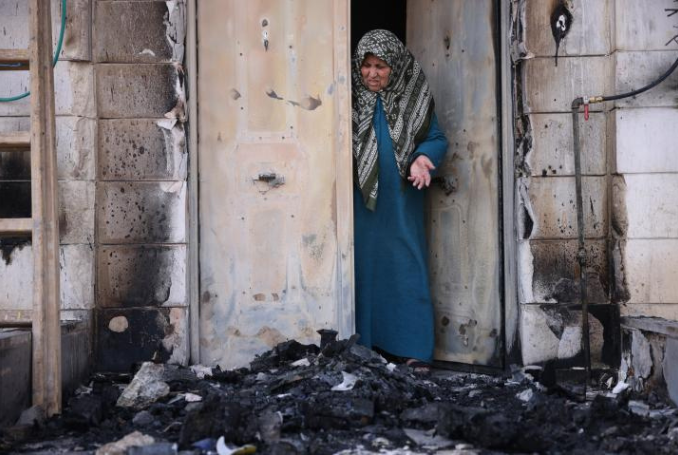 Un
lenguaje más incisivo y preciso a la luz de lo que vemos que ocurre a
diario en Cisjordania y en Jerusalén, donde se asesina sobre todo a
hombres jóvenes y a niños....,Mundo :: 11/04/2023
Un
lenguaje más incisivo y preciso a la luz de lo que vemos que ocurre a
diario en Cisjordania y en Jerusalén, donde se asesina sobre todo a
hombres jóvenes y a niños....,Mundo :: 11/04/2023 Las mujeres sostienen el 76,2% del cielo X Vijay Prashad.
Haití: Toussaint Louverture, el Precursor X Henry Boisrolin.
El legado de la lucha de Emiliano Zapata en América Latina. X Telesur / La Haine.
11 DE ABRIL DE 2023
Entrevista a Fernando Buen Abad, director del Instituto de cultura y comunicación de la Universidad de Lanús
Crisis civilizatoria y batalla comunicacional
Juicio político al presidente ecuatoriano
Guillermo Lasso, cerca del jaque mate
Videos Rebeldes
11 DE ABRIL DE 2023
Día del Joven Combatiente en Valparaíso
Mónica Llanca y Lumi Videla Historia de rebeldía: mujeres combatientes
Toma Pichicautin: Por el Derecho Social y Humano a la Vivienda Digna, Derecho al Agua, Alcantarillado, Suelo y Territorio
La política comercial chilena es un obstáculo al desarrollo
Ricardo Ruz Zañartu: Profesor primario, luchador popular, dirigente social, poeta y dirigente nacional del MIR
TRABAJADORES
Toma Pichicautin: Por el Derecho Social y Humano a la Vivienda Digna, Derecho al Agua, Alcantarillado, Suelo y Territorio
EDUCACIÓN
Toma Pichicautin: Por el Derecho Social y Humano a la Vivienda Digna, Derecho al Agua, Alcantarillado, Suelo y Territorio
DDHH
Aurora Rojas Briceño: Es fundamental visibilizar la historia de las mujeres, sus luchas y resistencias clandestinas, relevarnos de los roles impuestos
EL 23 DE ENERO 2023. EL MELINKA CUMPLE 39 años INDOCUMENTADO,ILEGAL,MOJADO,SIN PAPELES,CLANDESTA EN LA LUCHA POR TOD@S L@S INDOCUMENTAD@S Y PROLETARIOS DEL MUNDO,LA LUCHA CONTINUA.EN LOS EE.UU.
39 años de indocumentado en EE.UU.por Victor Toro Ramirez...,
El
23 de enero de 2023, se cumpliran 39 años del dia que ingrese a los
EE.UU.Viajando desde Mexico DF,pasando por muchos pueblos hasta llegar a
Juarez despues de varias intentonas atravesando el Rio Bravo fue el
Domingo 23 de enero de 1984 tras una nueva tactica de madrugada ocurrio
el paso por el Rio Bravo y desde ahi al Aero Puerto de la Ciudad del
Paso.TX,con EL THE DEL PASO TIME el periodico mas importante de la
Ciudad bajo el brazo,haciendo como UNA PARTE que lo leia en el cual una
foto mia salia en Primer Plano y con una Entrevista habia realizado
dias antes en la ciudad de Juarez,poco a poco nos fuimos adentrando
hacia el Avion que ya estaba con los motores prendido y que me podria
llevar hasta Alburqueque y pasar los controles de la Migra y asi lograr
el objetivo.Lo que se logro y asi llegar hasta los abrazos de L@s
Herman@s nos esperaban en el Aereo Puerto de Alburqueque,N.Mexico.Colectivo Miguel Enriquez
Colectivo Miguel Enriquez
















































































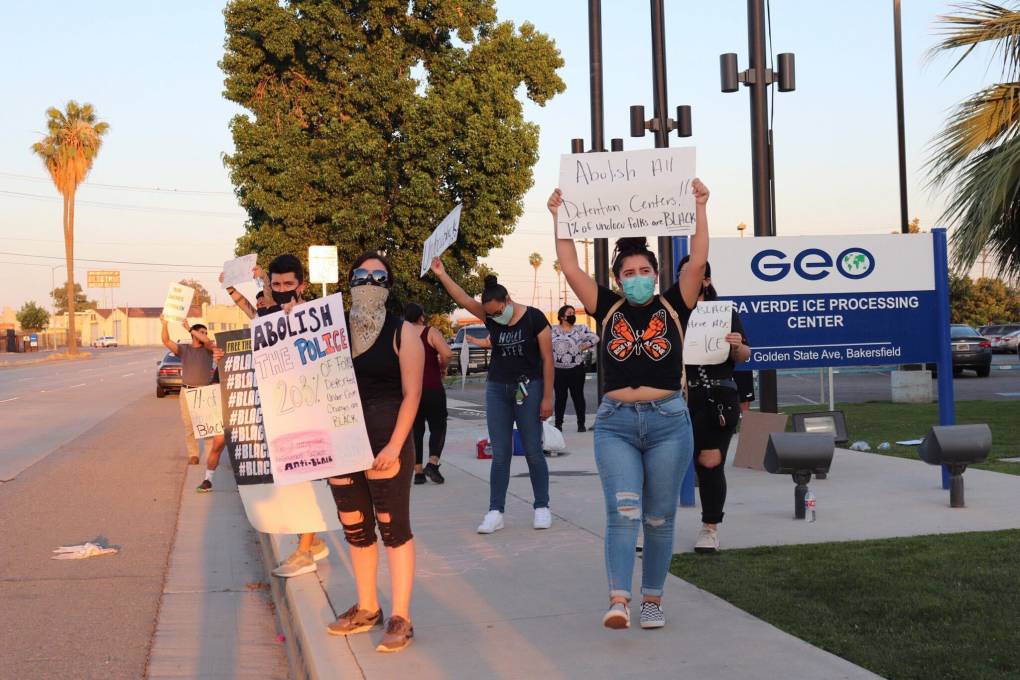



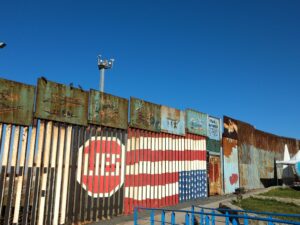




















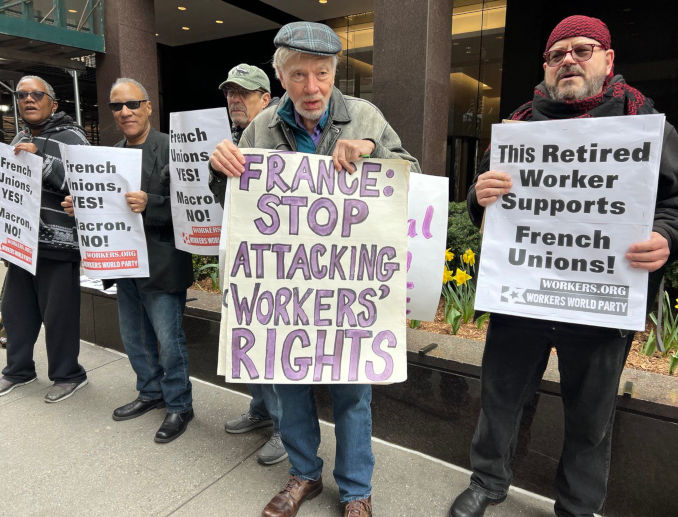
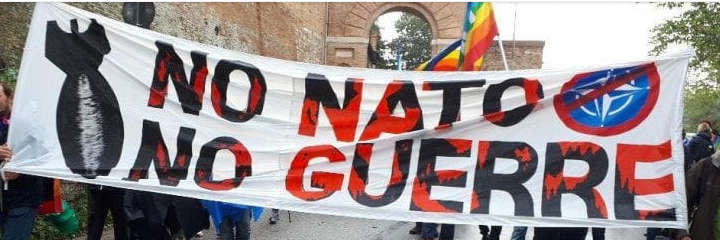
 A
new anthology from International Action Center and China U.S.
Solidarity Network contrasting the effective Chinese response to
COVID-19 with the disastrous response here in the U.S. It pushes back
against the racist anti-China campaign in the media.
A
new anthology from International Action Center and China U.S.
Solidarity Network contrasting the effective Chinese response to
COVID-19 with the disastrous response here in the U.S. It pushes back
against the racist anti-China campaign in the media.


No hay comentarios:
Publicar un comentario